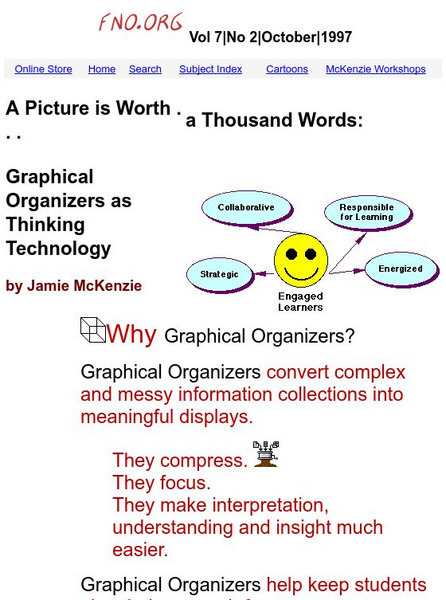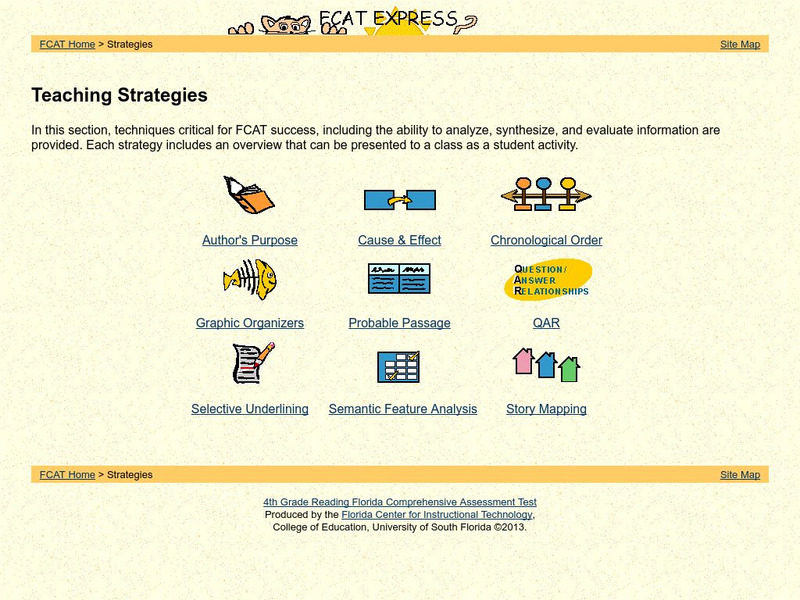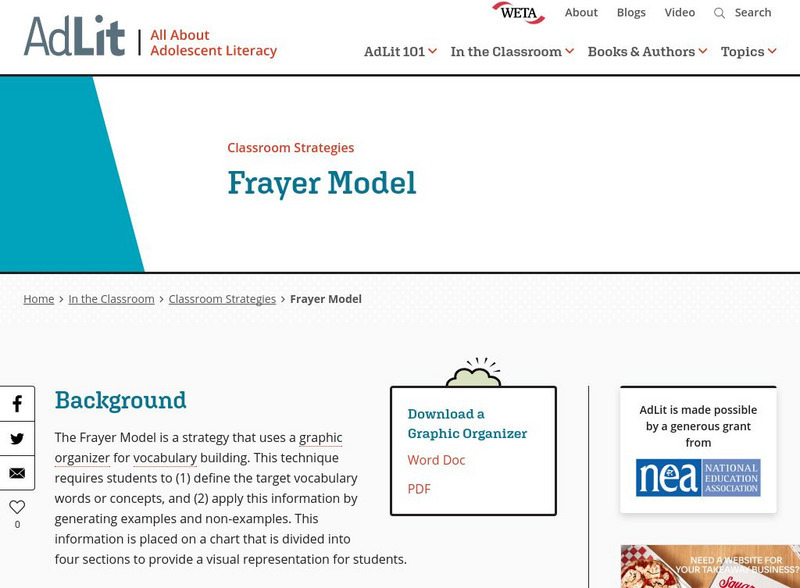Sophia Learning
Sophia: Easy to Create Graphic Organizers
Two PDF's that can be viewed online or downloaded and printed. The first is one page showing students several examples of abbreviations that can be used when taking notes. The second is a four pages and shows how different types of...
Other
Fdlrs: Thinking Maps: Examples From Brevard Public Schools
See examples of the use of the eight graphic organizers from Thinking Maps. These maps help students organize their learning and identify ways to reflect different kinds of text. The several examples from each grade K-6 show how to use...
Other
Graphic Organizers: Compare and Contrast: Herbivore Carnivore [Pdf]
This simple PDF graphic organizer t-chart will allow students to organize information about how herbivores and carnivores are alike and different. It also gives a photo example of each at the top of the page. Requires Adobe Reader.
FNO Press
From Now On: Graphical Organizers as Thinking Technology
From Now On explains the purpose and advantages of graphic organizers such as converting complex information into meaningful displays, helping students plan their research, and sometimes acting as mind maps. There are several examples...
Other
West Virginia Dept. Of Education: Teach 21: Examples of Formative Assessment
When incorporated into classroom practice, the formative assessment process provides information needed to adjust teaching and learning while they are still happening. The process serves as practice for the student and a check for...
Austin Independent School District
Austin Independent School District: The Writing Teacher's Strategy Guide [Pdf]
This comprehensive writing guide teaches writing strategies that can be used in any subject area and with any grade level. Each of the eleven chapters discusses and demonstrates a different element of good writing. Many also provide...
Writing Fix
Writing Fix: Constructed Response Organizer [Pdf]
This PDF is a graphic organizer designed two help students respond to a writing prompt.
Houghton Mifflin Harcourt
Holt, Rinehart and Winston: Elements of Literature: Identifying Figures of Speech [Pdf]
A graphic organizer which allows students to document and list the figures of speech they identify in a given piece of literature. These include simile, metaphor, personification, and symbol, and require examples from the text.
University of South Florida
Fcat Reading Grade 4: Teaching Strategies
This is a great resource that concentrates strategies and student activities in one place in an easy to use format, and can be navigated easily. Find great examples of probable passage, selective underlining, and semantic feature...
Sophia Learning
Sophia: I Just Got Assigned a Paper, Now What?
This lesson focuses on what to do after being assigned a paper; it provides the basic steps to writing a paper: brainstorm topics, organize your thoughts (Venn diagrams, tree diagram examples), conduct preliminary research, create a...
Houghton Mifflin Harcourt
Holt, Rinehart and Winston: Elements of Literature: Allegory Chart [Pdf]
A graphic organizer to understanding allegories in a given piece of literature. Fill in the sections on literal meaning, symbolic meaning, and the lesson presented.
Enchanted Learning
Enchanted Learning: 5 W's Diagrams
Enchanted Learning provides several examples of graphic organizers that can be used for gathering Who, What, Where, When, and Why information, either for reading comprehension or prewriting. These template suggestions can only be printed...
Writing Fix
Writing Fix: Personification [Pdf]
A graphhic organizer to help students brainstorm ideas for personification. A blank copy as well as a completed example are provided.
Intel Corporation
Intel: Seeing Reason: Mind Mapping Cause and Effect
The "Seeing Reason Mapping Tool" is a free online tool that teachers and students can use to foster cause and effect understanding. Teachers must register for free access and set up projects; then their students can use the projects...
Other
Kidspiration: Reading and Writing
Use Kidspiration 2 to retell a story using both pictures and words. Make sure to click on highlighted words at bottom of the page to see some examples.
ClassFlow
Class Flow: Poems Acrostic & Diamonte
[Free Registration/Login Required] Created by Robin Doggins - Acrostic and Diamonte Poems introduced through graphic organizers, examples and partner activities.
Montgomery CountyPublic Schools
Mcps: Frayer Model Gallery Walk
Explore how students can use graphic organizers to learn from each other.
Montgomery CountyPublic Schools
Mcps: Inspiration, Country Research Project
Explore how a teacher utilizes images, graphic organizers, and varies instruction to meet the academic needs of students.
ClassFlow
Class Flow: Concept of Definition Word Map
[Free Registration/Login Required] This flipchart demonstrates how to use a CD Word Map Chart to increase comprehension for students. There is a blank page to discuss the format, two CD Word Map Chart examples regarding geometric shapes,...
ClassFlow
Class Flow: Brainstorming
[Free Registration/Login Required] Several different examples of brainstorming: cluster/web, listing, circle graph, jot-chart/table. Has introduction, examples, and whole class brainstorming examples.
AdLit
Ad lit.org: Classroom Strategies: Frayer Model
The Frayer Model is a strategy that uses a graphic organizer for vocabulary building. This technique requires students to (1) define the target vocabulary words or concepts, and (2) apply this information by generating examples and...
Alabama Learning Exchange
Alex: Exponents Rule
During this lesson, eighth grade students will be introduced to the properties of integer exponents (i.e. multiplying powers, dividing powers, raising a power to a power). The students will view a slideshow presentation that will...
Other
Authentic Assessment Resources
You have just hit the jackpot for authentic assessment resources for professional development for teachers. Teachers will benefit from this comprehensive list of resources.
ClassFlow
Class Flow: Kickin' It Up!
[Free Registration/Login Required] This flipchart covers the three important areas of writing an essay: Unity, Coherence, and Elaboration. Graphic organizers are given as well as example prompts to practice each organizer with the students.




![Holt, Rinehart and Winston: Elements of Literature: Identifying Figures of Speech [Pdf] Graphic Holt, Rinehart and Winston: Elements of Literature: Identifying Figures of Speech [Pdf] Graphic](http://content.lessonplanet.com/resources/thumbnails/410154/large/bwluav9tywdpy2symdiwmduymc0yotywmi1ondh3nneuanbn.jpg?1589985628)


![Holt, Rinehart and Winston: Elements of Literature: Allegory Chart [Pdf] Graphic Holt, Rinehart and Winston: Elements of Literature: Allegory Chart [Pdf] Graphic](http://content.lessonplanet.com/resources/thumbnails/410051/large/bwluav9tywdpy2symdiwmduymc03nju5ltfzewxrzziuanbn.jpg?1589985124)











